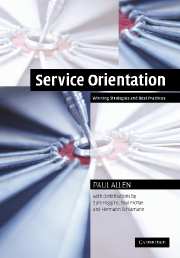Book contents
- Frontmatter
- Contents
- Foreword
- Preface
- Acknowledgments
- List of acronyms and abbreviations
- PART 1 OVERVIEW
- PART 2 BUSINESS ARCHITECTURE
- PART 3 SERVICE-ORIENTED ARCHITECTURE
- PART 4 SERVICE-ORIENTED MANAGEMENT
- PART 5 CASE STUDIES
- 14 Queensland Transport: a case study in service orientation
- 15 Credit Suisse: a case study in service orientation
- References
- Useful sources of information
- Index
15 - Credit Suisse: a case study in service orientation
from PART 5 - CASE STUDIES
Published online by Cambridge University Press: 31 July 2009
- Frontmatter
- Contents
- Foreword
- Preface
- Acknowledgments
- List of acronyms and abbreviations
- PART 1 OVERVIEW
- PART 2 BUSINESS ARCHITECTURE
- PART 3 SERVICE-ORIENTED ARCHITECTURE
- PART 4 SERVICE-ORIENTED MANAGEMENT
- PART 5 CASE STUDIES
- 14 Queensland Transport: a case study in service orientation
- 15 Credit Suisse: a case study in service orientation
- References
- Useful sources of information
- Index
Summary
Hermann Schlamann is a senior architect in the architecture group of Credit Suisse (CS), having worked as a consultant in the banking industry in Switzerland since the mid-1990s. Since starting his career in 1971, as a programmer of applications in technical engineering, Hermann has built a deep and extensive understanding of the practicalities of using methodologies to produce successful software.
In this chapter, Hermann shares his experiences in CS's transition to service orientation.
Introduction
Like many large financial organizations, CS has grown significantly, from relatively small beginnings since the 1970s. This period has witnessed huge changes in business and technology, which continue unabated. Service orientation has emerged as an important part of our strategy for managing these changes. However, it is an ongoing journey that has required careful nurturing. It has not happened “overnight.” In this chapter, we examine some of the lessons that we have learned along the road to service orientation and at how CS is responding successfully to the continuous demand for change.
Historical IT background
In 1974, the IT system of Schweizer Kreditanstalt consisted of one IMS mainframe system. In 1975, for reasons of capacity, the system was split into two IMS mainframe systems to support regional areas. In 1980, a new application, Wertschriften System Asset Management (WS80), was introduced. Three IMS systems were necessary for reasons of independence and the growing demand. In 1985, greater demands for availability and capacity, as well as 7/23 hours operation, made a fourth IMS system necessary.
- Type
- Chapter
- Information
- Service OrientationWinning Strategies and Best Practices, pp. 301 - 325Publisher: Cambridge University PressPrint publication year: 2006
- 1
- Cited by

